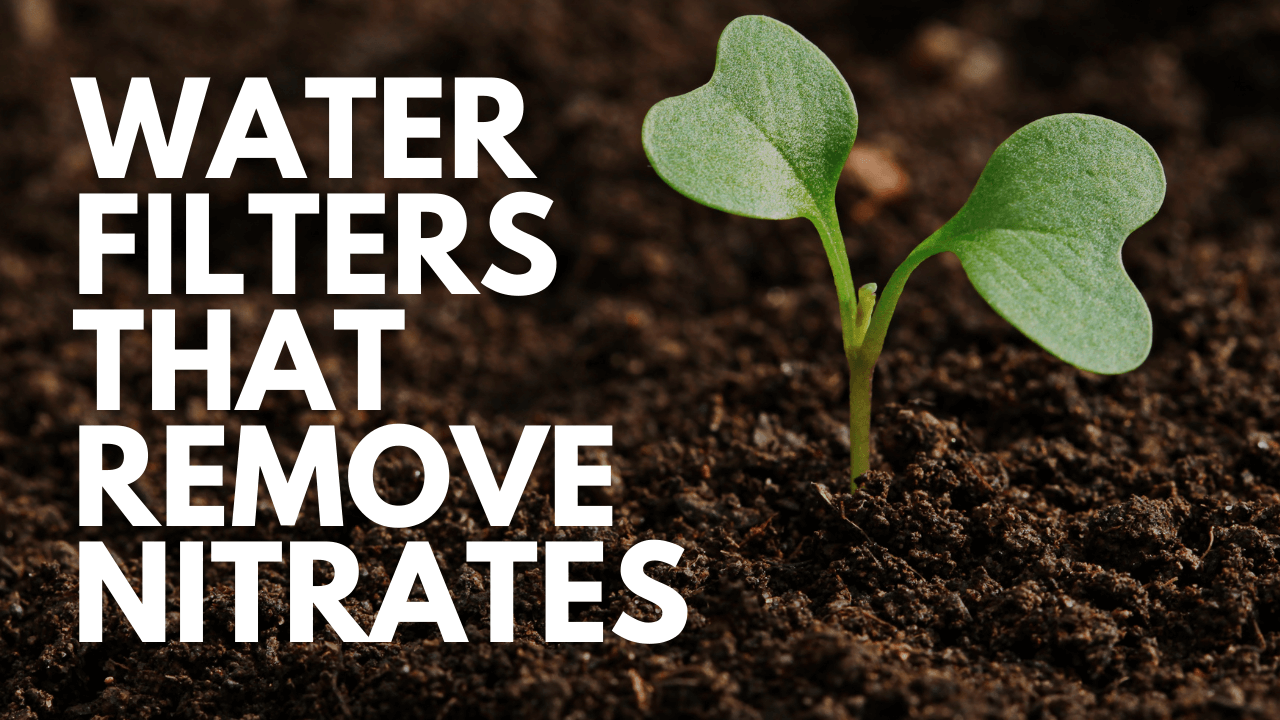Nitrates are a compound found naturally in the earth, but is a more common problem for well owners in Australia, particularly those living within agricultural or rural communities.
You can’t taste or smell nitrates, but consuming elevated levels of nitrates is very harmful to humans and animals.
In this article, we’ll attempt to educate you a little more on the topic of nitrates and share some water filters that remove nitrates from your family’s drinking water.
Table of Contents

How Do Nitrates End Up in Your Water?
Nitrates are one of the most common contaminants found in drinking water around Australia. This is because they're created by plant decomposition, animal waste or as an agricultural byproduct and can come from rainwater, floods or soil erosion, which are introduced into groundwater supplies.
Fertilisers for gardens, flowers and crops all use nitrates to enrich the soil with nitrogen to flourish and remain healthy. However, when these fertilisers are carried by rain or floods into streams, lakes or rivers, the nitrate levels in the groundwater increase.
Our bodies can withstand a small amount of nitrates, but excessive levels become harder and harder to detox.

How Nitrates Are Harmful to Humans
Nitrates are compounds that can find their way into our water sources, often from things like fertilisers from farms, leaky septic systems and animal waste.
While they're okay in small doses, high levels of nitrates in drinking water can be a real health risk, especially for infants under six months old. One of the biggest risks is a condition called methemoglobinemia, more commonly known as "Blue Baby Syndrome." This is where the nitrates interfere with the blood's ability to carry oxygen, which is really dangerous for small children.
For adults, very high levels of nitrates over a long time have also been linked to some health issues, so it's something everyone should take seriously. The primary concern is that our bodies can convert ingested nitrates into compounds that may increase the risk of several health problems, including certain cancers (like colorectal and stomach), thyroid gland disruption and adverse outcomes during pregnancy.
Water Filters That Remove Nitrates
The Centers for Disease Control and Prevention (CDC) has confirmed that you can treat your water from nitrates using three different filtration methods:
Reverse Osmosis (RO)
This is probably the most common and popular solution you'll find for homes in Australia, especially for under the kitchen sink.
How it Works: Think of an RO system as having a super-fine filter—called a semi-permeable membrane. High pressure is used to force your tap water against this membrane. The water molecules are tiny enough to squeeze through, but the larger molecules of contaminants get blocked.
Why it's Recommended for Nitrates: It's a simple matter of size. The nitrate molecules are physically larger than the water molecules. When water is forced through the RO membrane, the tiny pores effectively block the nitrates, along with other contaminants like fluoride, heavy metals and salts, from passing through. The contaminated water (called brine) is then flushed away down the drain, leaving you with purified water on the other side. It’s a highly effective physical barrier.
Ion Exchange
This method is a bit more like chemistry in action and is often used in whole-house filtration systems.
How it Works: An ion exchange system uses a special resin, usually made of tiny beads, that is covered in harmless ions—in the case of nitrate removal, it's usually chloride ions. As the water containing nitrates flows through this resin, the resin finds the nitrate ions more attractive than the chloride ions it's currently holding.
Why it's Recommended for Nitrates: This process is a direct chemical swap. The resin has a strong affinity for the nitrate ions, so it grabs onto them, pulling them out of the water. To keep its balance, it then releases one of its harmless chloride ions in exchange. It’s a one-for-one trade-off happening millions of times as the water passes through. Because it specifically targets and swaps out the nitrate ions, it's incredibly efficient at removing them from large volumes of water.
Distillation
This is the old-school, original method of water purification. It mimics the way nature makes rain.
How it Works: A distiller boils water until it turns into steam. This steam is then channelled into a cooling coil, where it condenses back into pure liquid water, which is collected in a separate container.
Why it's Recommended for Nitrates: It all comes down to boiling points and weight. Water turns into steam at 100°C, but nitrates, salts, heavy metals and other solids are non-volatile—they don't evaporate with the water. So, when you boil the water, the pure H₂O rises as steam, leaving the nitrates and other gunk behind in the boiling chamber. This separation process is what makes distillation so effective, resulting in some of the purest water you can get.

Reverse Osmosis Water Filters Remove Nitrates
Reverse osmosis is our number one recommendation for treating nitrates in your drinking water.
Reverse osmosis will effectively remove up to 95% of nitrates in your water depending on your original water temperature, quality and system pressure.
In this video, we explore the essential features to consider when choosing a reverse osmosis water filter system. Learn about the different types, from basic four-stage models to advanced five-stage and alkaliser systems, and discover why the pH of your water matters. Whether you're looking for a system to remove contaminants or add vital minerals back into your water, this guide will help you make an informed decision for cleaner and healthier hydration.
Our Top Choices for Reverse Osmosis Water Filters
To help with the RO water system decision, first, work out whether you require an under sink or benchtop system.
If you require a benchtop system for drinking, we recommend an RO 4000 Benchtop Reverse Osmosis Water Filter System with Standard Alkaline. You’ll get great tasting water with high alkalinity.
Otherwise, we recommend checking out the HPF 7 Stage Reverse Osmosis Under Sink Water Filter System.
This 7 Stage Reverse Osmosis water filter is designed to remove all nitrates and other contaminants to provide you with clean, great-tasting water and give a high alkaline pH reading between 8 to 9.5.
See our Buyers Guide to Reverse Osmosis to learn more about reverse osmosis and how to choose the right system for your needs.
In this video, discover the benefits of High Performance Filtration Undersink Reverse Osmosis Systems. Learn how these systems remove impurities, such as chlorine and chloramine, and deliver clean, great-tasting water right from your tap. With options for different water needs, from standard filtration to high pH water for specific health benefits, find the perfect solution for your home. Affordable, easy to maintain and backed by a quality Australian design, these systems ensure your family enjoys pure water every day. Watch now to find out which system suits you best!
If you require any further information or need help selecting the perfect filtration system for your home, please feel free to contact us. We’re always happy to help.
Nitrates, commonly found in Australian water sources due to agricultural runoff and natural decomposition, pose significant health risks at elevated levels, particularly "Blue Baby Syndrome" in infants, and are undetectable by taste or smell.
The most effective methods for removing nitrates from drinking water are reverse osmosis, which physically blocks nitrate molecules; ion exchange, which chemically swaps nitrate ions for harmless ones; and distillation, which separates pure water from contaminants through boiling and condensation.
For residential use, reverse osmosis systems, available in both under-sink and benchtop models, are highly recommended as a practical and efficient solution, capable of removing up to 95% of nitrates and other impurities.
Hear from Our Satisfied Customers
How Do Nitrates Actually Get Into My Drinking Water?
Nitrates can enter your water supply through various means, including the use of fertilisers on farms and gardens, waste from animals and leaky septic systems. Rainwater and floods can carry these nitrates from the soil into groundwater, streams and rivers.
What Are the Health Risks Associated With High Nitrate Levels?
High levels of nitrates in drinking water can be particularly harmful to infants under six months, potentially causing a serious condition called methemoglobinemia, or "Blue Baby Syndrome," which affects the blood's ability to carry oxygen. For adults, long-term exposure to very high nitrate levels has been linked to potential health issues, including an increased risk of certain cancers and thyroid problems.
Can I Simply Boil My Water to Get Rid of Nitrates?
No, boiling water will not remove nitrates. In fact, as the water evaporates during boiling, the concentration of nitrates can actually increase in the remaining water. The process of distillation, however, which involves boiling water and collecting the condensed steam, is an effective method for nitrate removal.










